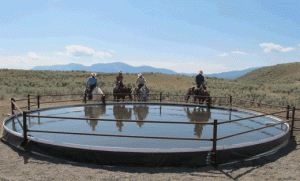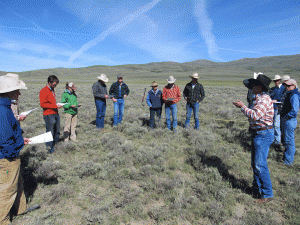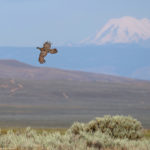Collaborative Partnerships Yield Big Gains in Montana’s Centennial Valley
 February 19, 2015
February 19, 2015
(Photo left: A bulldozer pulls in livestock water line on a ranch in the Centennial Valley.)
The most successful conservation gains for sage grouse come from collaborative partnerships among private landowners, government agencies and local groups. By working together on a variety of habitat restoration and grazing management projects, hundreds of thousands of acres of rangelands across the West are now more suitable for sage-grouse.
Take, for instance, the Centennial Valley Collaborative Grazing Project in southwest Montana. Launched in 2011, this project has proven a win-win for landowners and wildlife. This project involved several ranchers and local, state, and federal agencies. It’s a great example of how different land management objectives can be strategically met with science-based conservation practices. It’s also an example of how building trusting relationships is integral for protecting sagebrush habitat in the West.

This livestock water tank, funded through the NRCS EQIP program, protects sagebrush habitat and improves livestock operations. Photo: Byrhonda G. Lyons
“The land is healthier and our cattle are performing much better,” said Bryan Ulring, general manager of J Bar L Ranches, a private ranch that was involved in the project.
Here’s how the Grazing Project worked. With the use of targeted Sage Grouse Initiative dollars via the Farm Bill, field staff from the Natural Resources Conservation Service (NRCS) performed resource assessments on several ranches in the Centennial Valley, analyzing sage-grouse habitat in the area. Next, participating landowners received funding from the NRCS Environmental Quality Incentives Program (EQIP), which provides financial and technical assistance to farmers and ranchers to address natural resource concerns and deliver environmental benefits.

The NRCS’ Dillon field office hosts its annual range tour in the Centennial Valley. Photo: Byrhonda G. Lyons
EQIP provided financial assistance for a 10-mile livestock water line, fence markers near sage-grouse breeding leks, and wildlife escape ramps for all existing livestock water tanks. The livestock water line supplies water to 12 tank sites in 10 pastures. Local working groups and the U.S. Fish and Wildlife Service provided additional funds and labor for this project, which aims to maximize water efficiency and minimize maintenance hassles for landowners.
“The cooperative grazing plans have enabled us to change the season of use on about 50,000 acres,” Ulring said. “This will help species composition in the long run and certainly help improve residual cover. The project has helped our ranch be more sustainable, both ecologically and economically.”
A story on the Centennial Valley Collaborative Grazing Project, written by Byrhonda G. Lyons, originally appeared here on the NRCS Montana website.
Listen to a National Public Radio story by Christopher Joyce also on the Centennial Valley Partnership and showing how the Sage Grouse Initiative targets high priority landscapes to achieve wildlife conservation through sustainable grazing.





